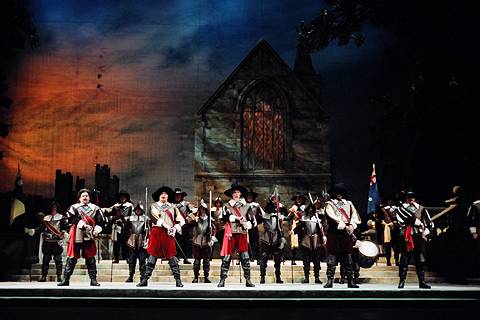|

Vibrant performance
Bellini's 'I Puritani' in Florida,
reviewed by LAWRENCE BUDMEN
The bel canto operas of Vicenzo Bellini (1801-1835) are endowed with an endless font of inspired melodies. In many ways Bellini's writing is the vocal equivalent of the keyboard music of Frederic Chopin (1810-1849). (Chopin's works are pianistic bel canto. The lives and careers of both composers were fairly contemporaneous.) Elegance and elasticity of musical line are essential requirements for artists who attempt the challenge of these composers' music. The daunting technical demands of bel canto opera -- particularly the works of Bellini -- have resulted in infrequent performances in recent years. Bellini's final opera I Puritani (1835) is his masterpiece. Perhaps Norma is more historically important but I Puritani called forth an endless profusion of gorgeous melodies. Unfortunately the libretto (by Carlo Pepoli) is a confused Romantic melodrama about the English civil war of the 17th century -- Oliver Cromwell and Parliament versus Royalists of the Stuart monarchy, Puritans versus Episcopalians and even the French Queen (a Roman Catholic). The inscrutable dramaturgy is redeemed by Bellini's profusion of beautiful areas and elegant, graceful choral and orchestral writing. The Palm Beach Opera presented a vibrant production of this bel canto milestone on 28 January 2005 at the Kravis Center in West Palm Beach, Florida, USA.

A scene from the Palm Beach Opera production of 'I Puritani'. Photo © 2005 Steven Caras
|
The Palm Beach production took an act to catch fire. Part of the problem was director Linda Brovsky's stock melodramatic staging and awkward grouping of the chorus on a raised platform across the rear of the stage. The set for Act 1 by designer Ming Cho Lee was a cramped staircase with landscape and a church tower in the distance -- thoroughly unconvincing and difficult for the singers to navigate. The Great Hall set of the second act was appropriately palatial (and gorgeous in flaming red) and the lovely outdoor terrace of Act 3 was a charming pastoral backdrop for the final scene. The costumes by Peter J Hall were appropriately dark and formal. Stephen Ross's lighting was particularly effective in the interior scenes (as when he bathed the Great Hall in streaming colors). Brovsky's direction, however, remained stilted throughout the production. Despite the problematical libretto, a director can clarify this work's emotional relationships (as Tito Caopobianco did so brilliantly in his production for the New York City Opera in the 1980s).
Continue >>
Copyright © 3 February 2005
Lawrence Budmen, Miami Beach, USA

|

